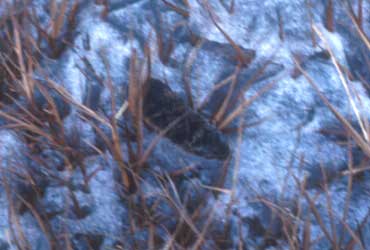
Land Animals
There are many animals that live on land in the Arctic. They range in size from tiny lemmings to hares to foxes to Caribou. There are also birds, plants, and marine animals that live in the Arctic.
Lemmings
Lemmings are the key to the Arctic food web. Eaten indirectly by virtually every animal in the Arctic, they are usually plentiful. They are the most common rodent on the wet Arctic plains. When overpopulated these animals will migrate in mass until they reach water then attempt to swim across it, drowning on the way. This is a way of reducing lemming population to fit the carrying capacity of the Arctic. Lemmings live in burrows with fur-lined chambers about 10-15 centimeters in diameter. These burrows improve the soil and allow certain grasses, which are the lemmings' preferred food, to grow.

Arctic hare
Hares are similar to rabbits. Preyed on by many of the larger animals, Arctic Hares help to alleviate the pressure on lemmings and are an alternative food. This animal is one of the few that does not range below the Arctic Circle. When living in the northern part of the Arctic Circle this species remains white throughout the year, but further south in the circle its coat darkens in the summer. This animal also has the unique talent of running solely on its hind legs.

Arctic fox
The arctic fox ranges throughout the Arctic. They are found on land. They also live on sea ice, sometimes traveling hundreds of miles from land. Its coat is white in winter and brown in summer. Arctic foxes do not hibernate in the winter. They are a scavenger and tend to eat animals that are already dead. They often travel in packs.

Caribou
Primarily eating reindeer moss, these large, shaggy animals are herbivores in spite of their grand size. Each day a single caribou needs about 2-3 kilograms of food. Because of the vast amount of food that they need and their large numbers, caribou must wander great distances to find food. Hunted by many animals, the caribou's speed saves it from extinction. They travel in herds of tens of thousands of individuals and are famous for long seasonal migrations. Each spring the caribou must travel from southern forests north to the tundra.
